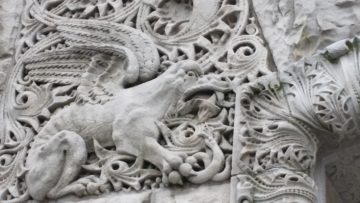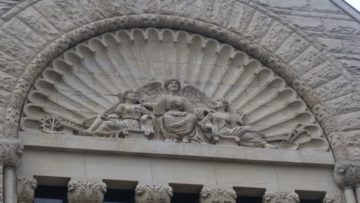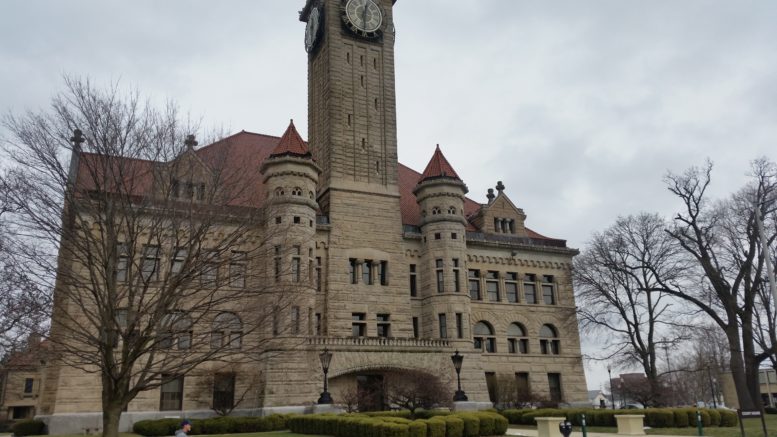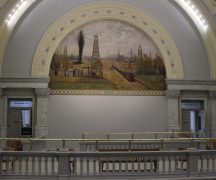By JAN LARSON McLAUGHLIN
BG Independent News
What do Jimmy Hoffa, Ronald Reagan and the KKK have in common? They all visited the Wood County Courthouse – for far different reasons, of course.
The grand Wood County Courthouse, which is recognized by many as an architectural wonder with ornate stonework, has seen more than 120 years of trials, political rallies and people coming in to do everyday business – pay taxes, get marriage licenses, attend public meetings.
Though he’s unlikely to give himself the title of courthouse historian, Wood County Auditor Mike Sibbersen is the official most people turn to when they want details about the grand structure. He can rattle off details long forgotten by others, but being an auditor and a stickler for details, he frequently checks his facts as he talks about the courthouse.

The courthouse has been the site of some dubious distinctions. Many know the story of Carl Bach who killed his wife, Mary, in 1881 with a corn knife. He was reportedly angry about his unsuccessful farming efforts and being forced to sleep in the barn.
Bach was the last man to be executed by hanging in Wood County, next to the previous courthouse on the same site. Tickets were sold to the public event, and a special execution edition of the newspaper was published. Remnants of the murder – Mary’s withered fingers, the corn knife used to chop them off, and the rope used to hang her husband – were on the display for years at the county historical museum.
A lesser known fact is that the sheriff who presided over the execution, George Murray “Murr” Brown, decided to make the most of the scaffolding used for the hanging, and built a porch on his home over on Conneaut Avenue, Sibbersen said.
Bach was not the only person to meet his demise on the courthouse grounds.

The courthouse was built with an elevator – which in itself was a rarity for back then. But the luxury led to the death of Joseph Danner, a courthouse janitor, who somehow fell down the elevator shaft in the darkness and died in 1916.
The courthouse actually had an elevator operator to help the public navigate their way through the building. In later years, the operator was only on duty when necessary. “He would come in during tax collections. There would be a lot of people then,” Sibbersen said.
There was also the case of the former candidate for county auditor, J.H. Ward, who was devastated by his unsuccessful campaign for the office in 1905. Ward was being housed in the county jail due to mental illness brought on by his loss. He reportedly used a gun that belonged to the jail matron to kill himself. A newspaper article said Ward suffered from “softening of the brain” from his unsuccessful bid for office.
But back to the original question about Hoffa, Reagan and the KKK.
Hoffa, the famous American labor union leader who disappeared in 1975, came to the Wood County Courthouse in 1937 to get a marriage license to wed Josephine Poszywak, of Rossford. Their framed marriage license still hangs on the wall of the courthouse probate office.
Hoffa, who listed his occupation as “organizer” and his residence as Detroit, was one of many people who came to Wood County because of its reputation as a “marriage mill.”
Wood County Probate Judge Dave Woessner said in those days getting a license took less time here than in Michigan. “It was very easy to come down and get a license and get married,” he said.
As far as Reagan, he was one of two U.S. presidents to hold political rallies on the front steps of the courthouse. He graced the steps in 1988, and the other president, William Howard Taft, held a rally there in 1912.
The Ku Klux Klan also held two rallies in front of the courthouse in the 1990s. In those cases, the community held counter peace gatherings elsewhere in Bowling Green to show the local disdain for the KKK.
The building itself also has its own stories to tell. Ground was broken for the structure on 1893, the cornerstone was laid in 1894, and the building was completed in 1896 for the cost of $255,746.84. (As county auditor, it’s to be expected that Sibbersen had the cost down to the penny.)
“The county was prosperous,” he said. “The oil boom was on.”

The stately building as made from sandstone sent from Amherst, Ohio, granite from Vermont, and marble from Italy. The stained glass panels in the ceiling of the third floor still cause visitors to “ooooh” and “aaaaah.”
When built, the clock tower rising high above Bowling Green, boasted clock hands stretching 16 feet – the second largest in America – close behind the 16.5 feet clock hands at the Chronicle newspaper building in San Francisco.
The original clock hands made of basswood, however, soon had to be replaced by metal hands.
“The pigeons roosted on them right away and knocked them out of time,” Sibbersen explained.
The basswood clock hands have been preserved as a part of the collection at the county historical museum.
The clock tower is now the home to a couple Peregrine falcon parents, waiting for a nest of four babies to hatch. A camera gives people a chance to peek in on the pair.
The massive murals on the third floor were also not original to the courthouse, but were added later by artist Isaac M. Taylor, who was mayor of Bowling Green in 1910-1911.
Taylor painted the working oil fields of the Portage area, and a scene from Fort Meigs in Perrysburg. “He did his best at what the fort looked like,” since it had not been recreated at that point as a historic site.
Sibbersen also likes to share the stories of some long-time employees of the courthouse. Julia Cramer holds the distinction of being the longest employee, having worked 54 years in the county treasurer’s office. Her sister, Molly Cramer, worked nearly as long in the auditor’s office.
The two spinster bookkeepers shared a home close to the courthouse.

As he gives tours of the grand building, Sibbersen likes to point out the ornate stone carvings – in particular the allegory above the windows on the east side of the courthouse. The late Common Pleas Judge Gale Williamson was the first to bring to Sibbersen’s attention the etching that seemed to have a moral tone.
The figure in the middle represents the law. To the right is agriculture holding a sheath of grain, and to the left is commerce holding an anvil and gears.
“The law figure has its hand benevolently on the shoulder of agriculture, but points in a warning manner toward business,” Sibbersen said. The image appears to indicate that the law should be gentle with agricultural efforts, but keep a watchful eye on commercial pursuits.
“It says something about the times in the 1890s,” he said.





